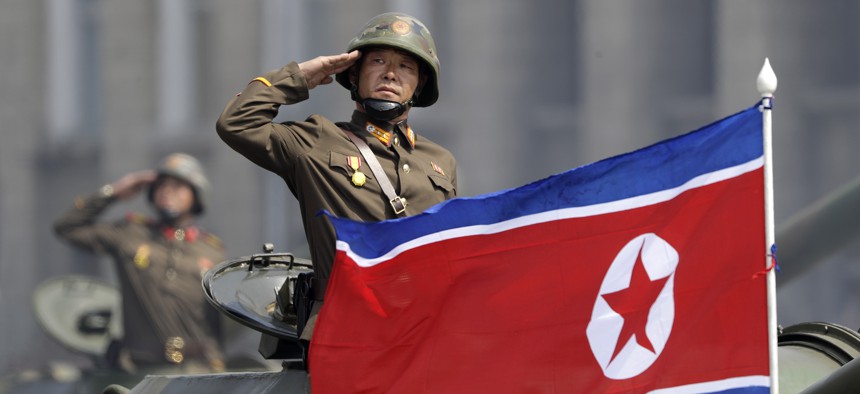
Soldiers in tanks are paraded across Kim Il Sung Square during a military parade on Saturday, April 15, 2017, in Pyongyang, North Korea. Wong Maye-E/AP
North Korea Is Helping China in the South China Sea—Whether It Knows It or Not
Pyongyang’s rocket tests have elbowed Beijing’s land grab out of the spotlight — just as the Chinese might have hoped.
Like most of the world, China is fed up with North Korea, which yesterday (May 29), in defiance of international pressure, conducted its third missile test in three weeks. The unpleasant neighbor is steadily progressing toward its goal: the ability to hit much of the world, including the US mainland, with nuclear-tipped intercontinental ballistic missiles.
But, for Beijing, North Korea’s saber-rattling does serve one useful purpose: It distracts attention from the contested South China Sea. Last year, the world fretted over China’s territorial aggression in that resource-rich waterway, with critics warning it could become virtually a “Chinese lake.” Beijing claims nearly the entire sea, based on what an international tribunal ruled last July to be bogus reasoning, both legally and historically.
Now, thanks largely to North Korea, the issue has faded into the background—just as China might have hoped.
When US secretary of state James Mattis appeared on Face the Nation this past Sunday (May 28), he talked at length about North Korea, which he described as a “direct threat” to the United States, adding that a conflict there would be “probably the worst kind of fighting in most people’s lifetimes.”
The South China Sea didn’t come up.
That was notable since just four days earlier the US conducted a “freedom of navigation” operation (Fonop) in the sea’s Spratly archipelago, where China has been steadily improving upon seven militarized islands it’s built atop reefs. Taking place at Mischief Reef, it was the first Fonop under Trump, and some took it as the start of a more challenging stance.
More likely, though, the operation was timed for the June 2 Shangri-La Dialogue, an annual meeting in Singapore of the region’s defense ministers. It would have been difficult for Mattis, who will attend the gathering, to reassure his counterparts about America’s ongoing commitment to the area without having done a single Fonop since Trump took office.
Meanwhile China continues to make steady progress fortifying its military installations in the sea, while on the diplomatic front it routinely warns other nations against saying or doing anything that challenges its stance. For instance, it recently fitted out its manmade island at Fiery Cross Reef with an anti-frogman rocket launcher defense system, and it admonished Japan and New Zealand for agreeing that last July’s ruling should be adhered to with regards to the South China Sea.
North Korea has its own reasons for attracting attention to its weapons tests and improving capabilities. It has a long history of selling arms to other countries, including Syria and Iran, and each test serves as an advertisement of sorts. (It faces sanctions on selling arms but has shown it can work around them.) Greater offensive capability also means greater negotiating power in any future talks about reducing arms. Pyongyang cashed in after conducting its first test of a nuclear bomb in 2006. It soon received a substantial US-led aid package in exchange for denuclearizing (which never happened).
US secretary of state Rex Tillerson said in late April that the US isn’t interested in forcing regime change in North Korea and instead wants to begin negotiations about denuclearization.
Meanwhile Trump has indicated that, in exchange for help on North Korea, he’s willing to be less tough on China in other areas, including trade. He said in late April:
“I think that, frankly, North Korea is maybe more important than trade. Trade is very important. But massive warfare with millions, potentially millions of people being killed? That, as we would say, trumps trade.”
He’s likely applying the same logic to the South China Sea. A recent Foreign Affairs column noted,
“Exactly why the South China Sea has fallen off the administration’s agenda is not clear. But it is possible that U.S. officials have decided to lift the pressure on China’s maritime outposts because they believe that doing so could help secure Beijing’s help in managing North Korea.”
Meanwhile a transcript of a recent call between Trump and Philippines president Rodrigo Duterte showed the US president urging his counterpart to call Beijing and “tell them we are all counting on China” with regards to pressuring North Korea.
When it comes to the South China Sea, both Trump and Duterte have been accused of being soft on Beijing. According to the transcript, the issue of the sea didn’t come up at all during their conversation. Duterte warned Trump that North Korean leader Kim Jong-un is “playing with his bombs” and “might just go crazy.”
China’s strategy in the sea has been described as “salami slicing,” as in making advances just small enough to avoid a strong reaction, and then slowly continuing to do that. It’s already achieved much in the South China Sea using this subtle tactic. North Korea’s attention-grabbing antics are making it all the easier to pull off.